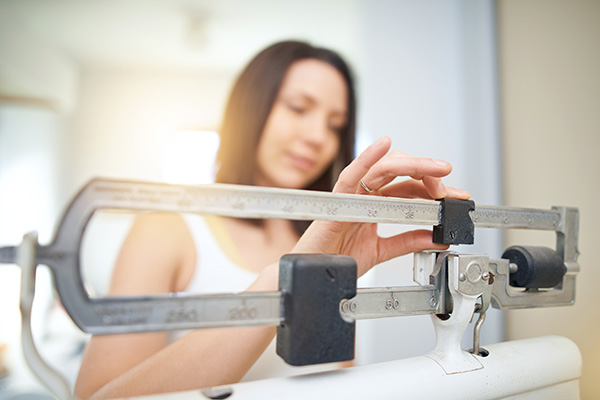By WHN Editorial Team
A lot of women think that perimenopause and weight gain go hand in hand — and that there’s nothing you can do to stop it (or reverse it). While it’s true that many women do become weight loss resistant during perimenopause, you absolutely can do something to change that!

Why hormonal imbalance leads to weight gain — and weight loss resistance
Over 80% of the women who have taken our menopause quiz have revealed they are struggling with perimenopausal weight gain. There’s no real surprise why.
In perimenopause (the time before menopause), your estrogen levels fluctuate and fall compared to other hormones. When these hormonal changes begin, your body will attempt to produce as much estrogen as possible to keep all your hormones balanced at previously “normal” levels. Since your ovaries are naturally making less estrogen, however, your body searches for other sources for the hormone. Did you know that your fat cells (especially hormonally active belly fat) actually produce weak estrogens? They do, so your system will start to produce more and more fat in an attempt to replace the estrogen previously supplied by your ovaries.
This is the reason why women in perimenopause often see a change in fat deposition on their bodies, shifting from the hips and thighs to mostly around the midsection. It’s not about calories or willpower…this weight is purely there due to a hormonal imbalance. And while abdominal weight gained during perimenopause may feel anything but active, the truth is it is working — to produce even more belly fat.
This vicious cycle is further fueled by stress, high cortisol levels and blood sugar imbalances, which are all common at this time of life. These changes create an even greater imbalance between the sex hormones (especially estrogen and testosterone), forcing even more fat production.
Because your body views this fat as vital for your hormones, it doesn’t want to let go of it, throwing you into a state of weight loss resistance in which the body will try to hang onto this weight no matter how strict your diet. Weight loss feels next to impossible.
Release stubborn weight naturally
The great news is that by making some simple changes you can help naturally reset the balance between your sex hormones, sending a signal to your body that it no longer needs the excess fat.
3 steps to overcome estrogen-related weight loss resistance
1. Rebalance with herbal support. You can use targeted phytotherapeutic herbs to naturally bring estrogen levels back into balance. We’ve formulated a hormone-balancing herbal combination of black cohosh, red clover, kudzu, passionflower, ashwagandha and more that adapts to the hormonal needs in your body. This combination can ease your hormones back into balance and eliminate bothersome symptoms. With the burden of hormonal imbalance lifted, your body can overcome weight loss and finally release the stubborn weight.
2. Don’t deprive yourself of food. Balanced meals and snacks are the only way you’ll be able to stick with a new eating approach. Each meal should include some form of protein, fiber, healthy fat and complex carbohydrates. Avoid processed foods that are filled with unhealthy fats and sugar and hormone-disrupting chemicals and preservatives.
3. Boost your metabolism. Do everything you can to make it easier for your body to metabolize fat. Aside from the well known metabolism boosters like exercise, a good night’s sleep and healthy foods, you can support your metabolism with green tea extract, chromium and herbs. We’ve just discovered a blend of Indian sphaeranthus and mangosteen that can do wonders for fat burning. We’ve put these herbs and more in our M-Boost, a metabolic formula for weight loss.
Read More: Meno belly fat is different from other fat — and so is how you lose it
References and further reading
Vicennati, et al. 2002. Response of the hypothalamic–pituitary–adrenocortical axis to high-protein/fat and high-carbohydrate meals in women with different obesity phenotypes. J. Clin. Endocrinol. Metab., 87 (8), 8984–3988. (accessed 03/04/2009).
Schwarzbein, D., & Deville, N. 1999. The Schwarzbein Principle. Deerfield Beach, FL: HCI.
Lukanova, A., et al. 2004. Body mass index, circulating levels of sex-steroid hormones, IGF-I and IGF-binding protein-3: A cross-sectional study in healthy women. Eur. J. Endocrinol., 150 (2), 161–171. (accessed 03/04/2009).
Azziz, R. 1989. Reproductive endocrinologic alterations in female asymptomatic obesity. Fertil. Steril., 52 (5), 703–725. (accessed 03/04/2009).
Sites, C., et al. 2007. Effect of a daily supplement of soy protein on body composition. Fertil. Steril., 88 (6), 1609–1617. (accessed 03.05.2009).











